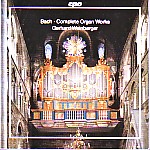Recorded between 1997 and 2008, Gerhard Weinberger’s complete Bach organ music cycle may be the most comprehensive on the market. Its 22 discs bring together all of the authentic compositions, plus numerous works once credited to Bach but now deemed spurious, all of the composer’s arrangements, recent discoveries, variant texts, plus, for good measure, The Art of Fugue. Weinberger utilizes no less than 24 different North German baroque organs located in venues with acoustics that range from dry as dust (the Heinrich Gottfried Trost organ on Disc 7) to excessively reverberant (the Hildebrandt organ in Naumburg on Disc 15). His artistry is similarly variable.
Sometimes Weinberger displays a severe and rather pedantic temperament (borne out in the Trio Sonatas and the C minor Passacaglia), as well as an inability to give in to the great showpieces’ surface panache (the famous D minor Toccata and Fugue, the great “St. Anne’s” E-flat Prelude and Fugue). At the opposite end of things, rhythmic instability causes polyphonic textures to lose shape, as heard in the C major (BWV 545) and E minor (BWV 532) fugues and throughout much of The Art of Fugue.
Yet the three-part G major Fantasia BWV 571 and Ricecare from A Musical Offering reveal Weinberger’s ability to maintain a firm, underlying pulse and characterful contrasts when he chooses. Moreover, Weinberger’s fluent phrasing and clear registrations do stylish justice to the numerous lyrical chorale preludes. The organist’s well-written annotations provide valuable musical insights and information about the instruments. While I respect this set’s unquestionable scholarly value and effective programming from disc to disc, the excellent though markedly different Bach organ cycles by Hans Fagius (BIS), Peter Hurford (Decca), and Helmut Walcha (DG) offer greater interpretive consistency.
































